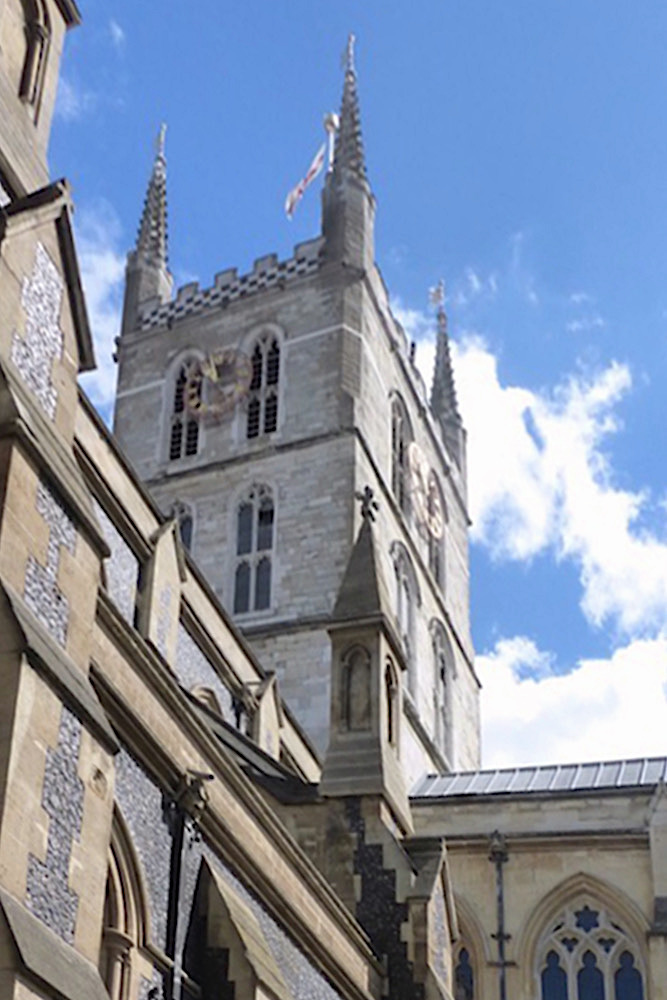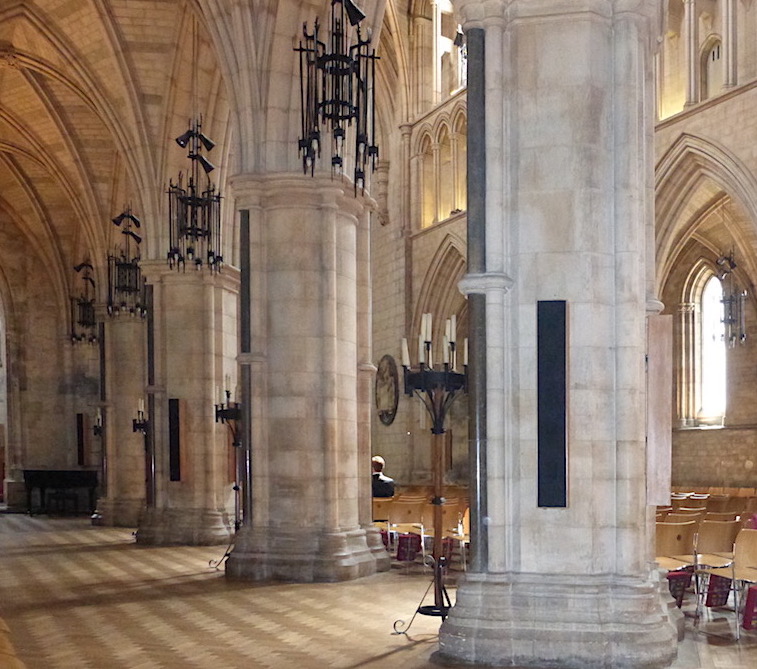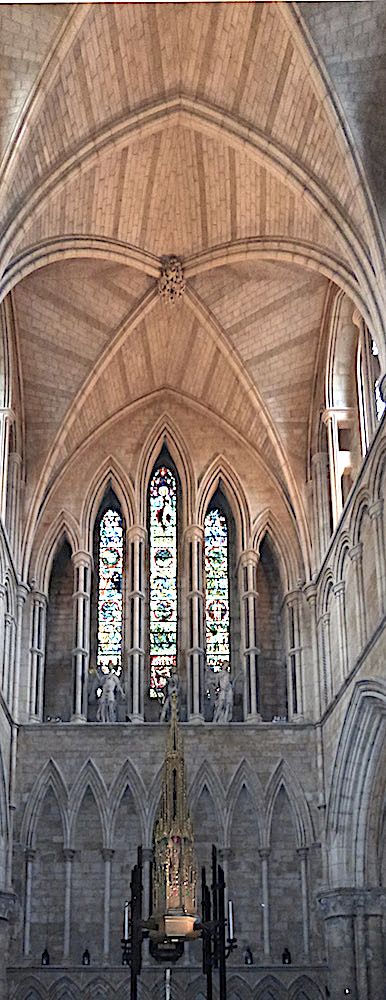



Left to right: (a) Seen from the east end, with the tower rising above the crossing. (b) The tower, with the beginning of the south transept. (c) The churchyard on the south side, showing the buttressing. The one grave here is that of George Gwilt, who worked on the retro-choir in the early 1830s. (d) The south-west entrance, with the carved figure of Jesus above the doors.
Southwark Cathedral, 1220-1420, on the South Bank, London. The full name of this Grade I listed building, is the Cathedral Church of St Saviour and St Mary Overie (meaning "over the river — on the south bank of the Thames). Despite its ancient beginnings, it only became a cathedral, and the mother church of the Anglican diocese of Southwark, in 1905. That was after major restoration work in the nineteenth century. In particular, the nave and south transept were replaced twice during the Victorian period — once by Henry Rose (d. 1853) in 1839-40, so poorly that A. W. N. Pugin condemned the result as "vile" (qtd. in Worley 32); and then, much more successfully, in 1890-97 by Sir Arthur Blomfield. Although the style is appropriately thirteenth century Gothic, much of the cathedral's light and airy appearance today, as the visitor first enters it, is due to Blomfield (see Curl and Wilson 90).

"Proposed restoration in St Saviour's Church, Southwark; foundation stone laid by the Prince of Wales, July 24th, 1890" (Worley, following the index).

Blomfield's outline of the church, showing the extent of his proposed new work, also following the index in Worley. Disappointingly, the late Victorian rebuilding of the nave and the "east responds" have been described as "competent but dull" (Cherry and Pevsner 569); but many will disagree with the second part of that verdict.
As clearly seen in the photographs, the materials used were knapped flint with stone dressings, with tower and transepts of ashlar. Cruciform in plan, with a central crossing, the cathedral has short north and south transepts and a stout central tower with clock faces. It has its own rich website (see bibliography) but it is worth stressing here the extent of its importance: its diocese stretches from Kingston-upon-Thames in the west, to Thamesmead in the east, and to Gatwick Airport in the south; this includes as many as two-and-a-half million people in over 300 parishes ("Our History," also explained in the short guide available at the church).
Interior



Left to right. (a) Looking east towards the early sixteenth-century High Altar Screen, erected by Bishop Fox of Winchester and carved with saints and other figures associated with Southwark (the detail mostly dates from later periods). (b) Looking into the south aisle. (c) Looking into the north transept, with its main window by Charles Eamer Kempe.
The Cathedral has a seven-bay nave, and is more spacious than appears here. Although the crossings are not very long, it is wide enough beyond them to encompass (just east of the north transept, and next to the north choir aisle) the Harvard Chapel for quiet prayer. This was "largely by Blomfield, 1907" (Cherry and Pevsner 569). Here can be found the spectacular tabernacle designed by A. W. N. Pugin. Also according to the listing text, the lectern, pulpit and stalls all date to the restoration of the 1890s. On the other side, in the south choir aisle, is the organ case designed by Blomfield himself in 1897. Beyond the screen is the the oldest complete part of the church, the retro-choir, restored as closely as possible to its original condition by Gwilt (see above) in 1832. There are four chapels in this eastern part, dedicated to St Andrew and St Christopher on the left, and the Virgin Mary followed by St Francis and St Elizabeth of Hungary on the right.



Left to right: (a) West end, with the beautiful "Creation" window of 1893 by Henry Holiday (see Eberhard). Also seen here is the top of the spectacular wooden font cover. (b) The cover in full. (c) The font.
The west end of the cathedral, where the visitor enters, is particularly light and airy. On the right, of course, is the nave, but immediately ahead is the elegant Verde di Prato marble font, designed by George Frederick Bodley (see Worley 66), and above it on the left is Henry Holiday's west window, The Creation, with wooden carvings of King David and two trumpeting angels on the sill below. These were taken from the old organ case of 1703, and are nicely described by Bridget Cherry and Nikolaus Pevsner as "spirited" (569).

Thomas Francis Rider, Blomfield's builder, vignetted in the "Builder's window" of the 1920s by Laurence Lee, in the south aisle. There are several similar vignettes of Rider's men at work, reminding us that this cathedral, like others, is the work of many, many hands.
There are many additional points of interest in the cathedral, including the tombs of the medieval poet, John Gower, and of the great preacher Bishop Lancelot Andrewes, who helped to prepare the King James version of the Bible in 1611. Among many literary associations is that with Shakespeare, who lived in Southwark. There is a much-photographed Shakespeare Memorial and window, and an inscription in the choir paving to Shakespeare's bother Edmund, who was buried here in 1607. Several of the other stained glass windows celebrate local authors, such as Bunyan and Dr Johnson (follow the link to C. E. Kempe's windows in "Related Material").
The first image on the left was kindly contributed in 2007 by a commercial photo library, "London Photos," which is no longer found at the original site. It was added, with caption material, by our founder, webmaster, and chief editor, George Landow. The remaining photographs were taken by Jacqueline Banerjee, who also obtained the scanned images and added the commentary and bibliography. You may use these images without prior permission for any scholarly or educational purpose as long as you (1) credit the photographer and (2) link your document to this URL in a web document or cite the Victorian Web in a print one. [Click on the images to enlarge them.]
Related Material
- Pugin's tabernacle
- Two tapestries attributed to Bodley in the choir aisles
- Memorial to Deaconess Isabella Gilmore
- Henry Holiday's west window, the Creation
- Sir Ninian Comper's east window, with Christ in Majesty flanked by the Virgin Mary and St John
- Windows by C. E. Kempe or C. E. Kempe & Co. (a sample)
- Windows by Ward and Hughes
Bibliography
Cathedral Church of St Saviour and St Mary Overie (Southwark Cathedral), Cathedral Street." Historic England. Web. 20 August 2018.
Cherry, Bridget, and Nikolaus Pevsner. London 2: South. New Haven and London: Yale University Press, 2002.
Curl, James Stevens, and Susan Wilson. Oxford Dictionary of Architecture. 3rd edition. Oxford: Oxford University Press, 2015.
Eberhard, Robert. "Stained Glass Windows at Cathedral, Southwark, Inner London." Church Stained Glass Windows. Web. 20 August 2018.
"Southwark Cathedral: Cathedral Guide: A Tour of Southwark Cathedral. Available from the cathedral. This material, and more, is also online on the cathedral's own website, at Southwark Cathedral: Our History."
Worley, George. Southwark Cathedral, formerly the Collegiate Church of St Saviour, otherwise St Mary Overie: A short history and description of the fabric, with some account of the college and the see. Project Gutenberg. Web. 20 August 2018.
Last modified 24 November 2023